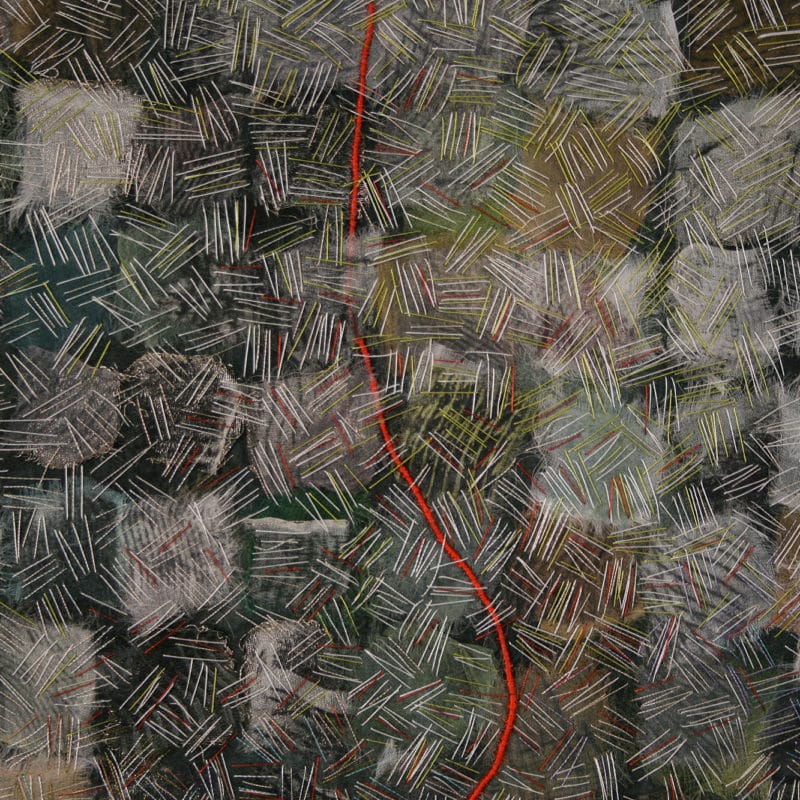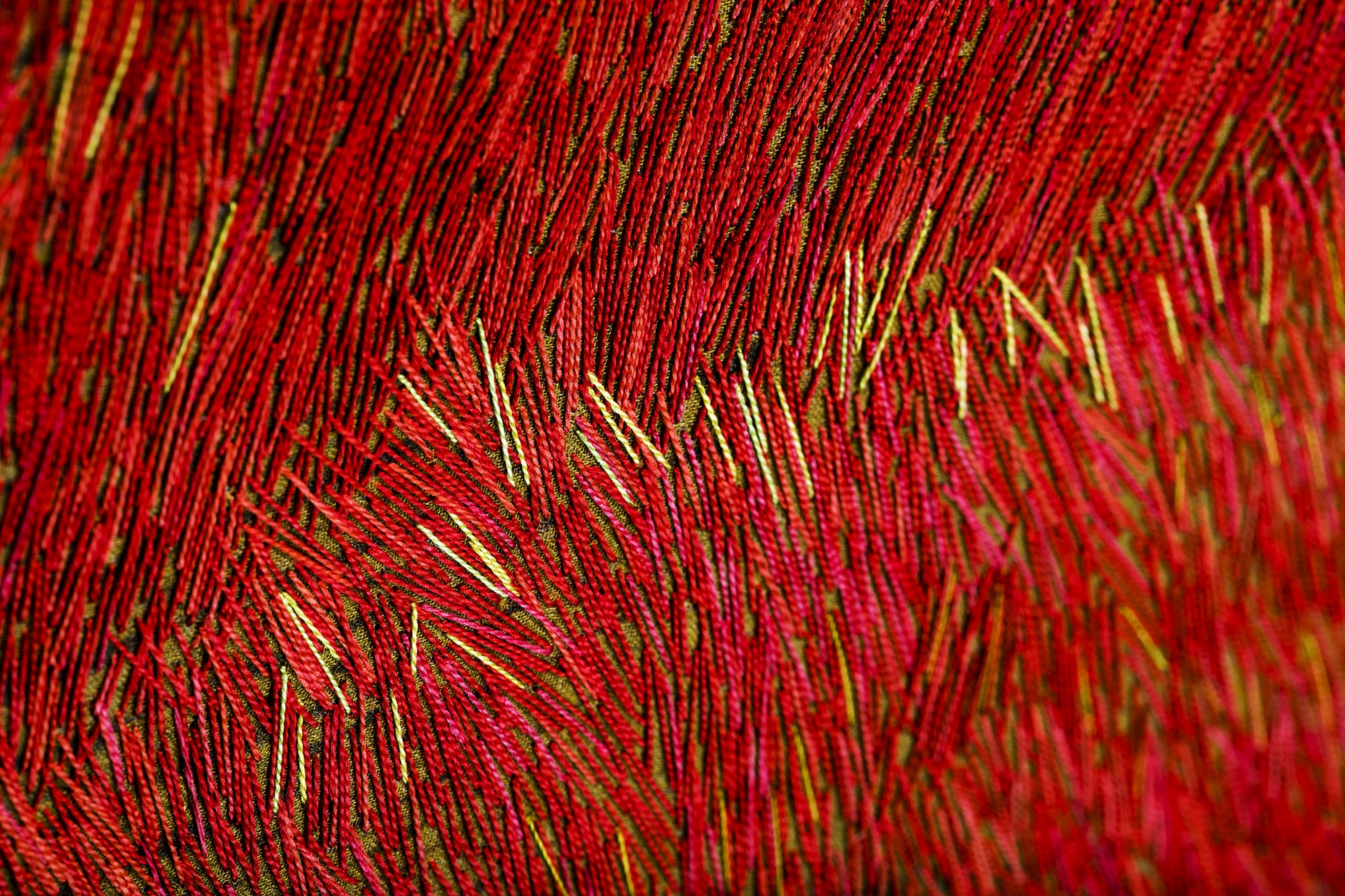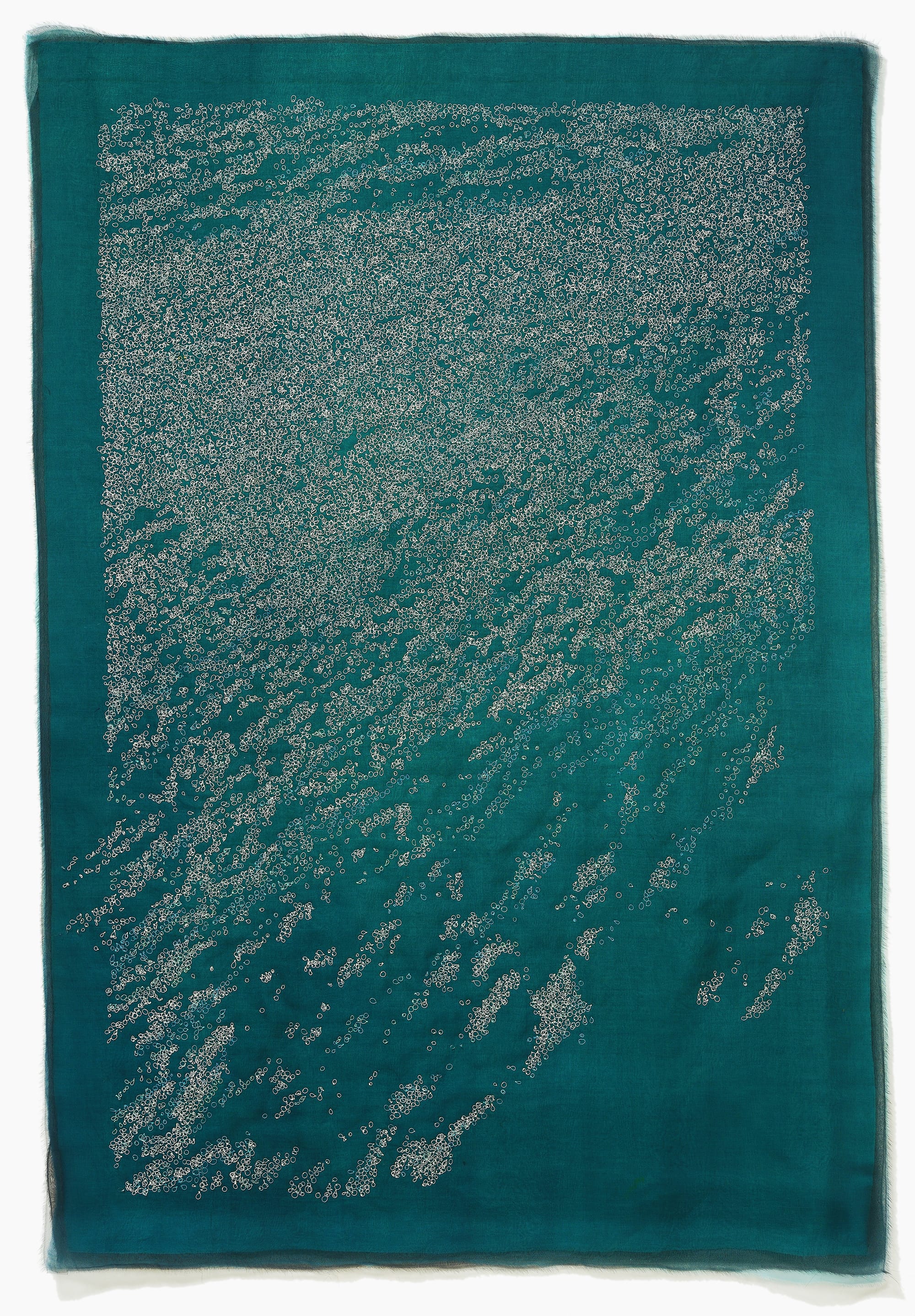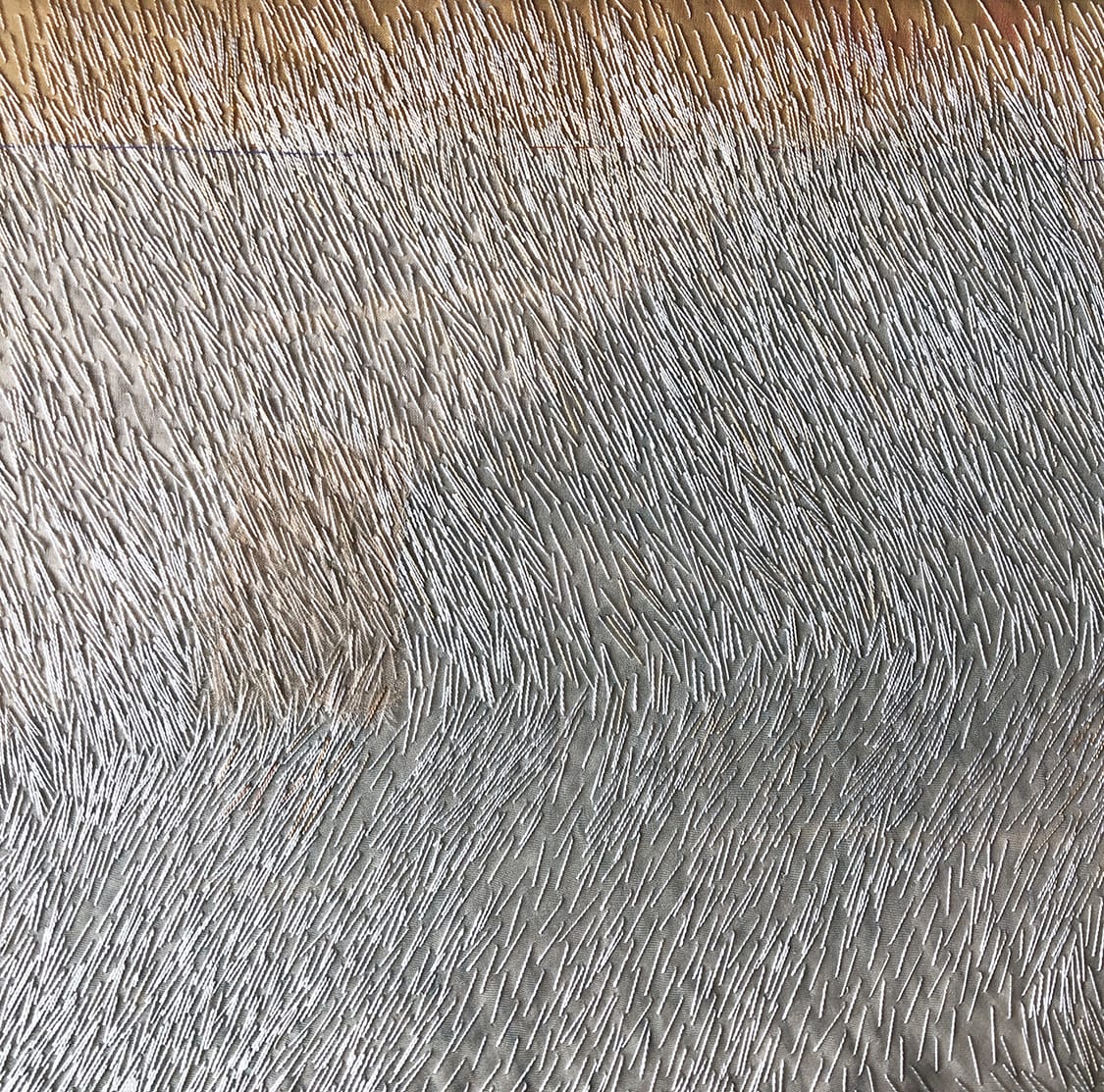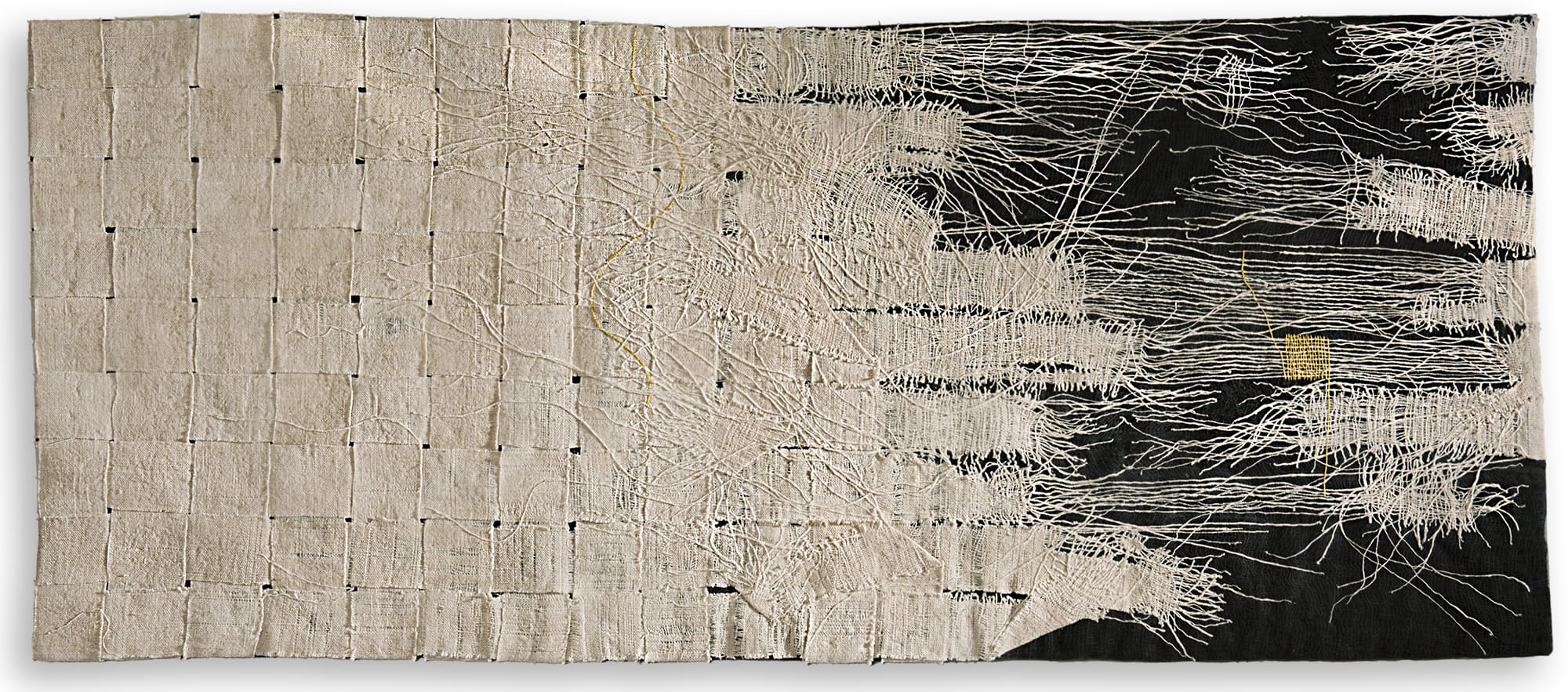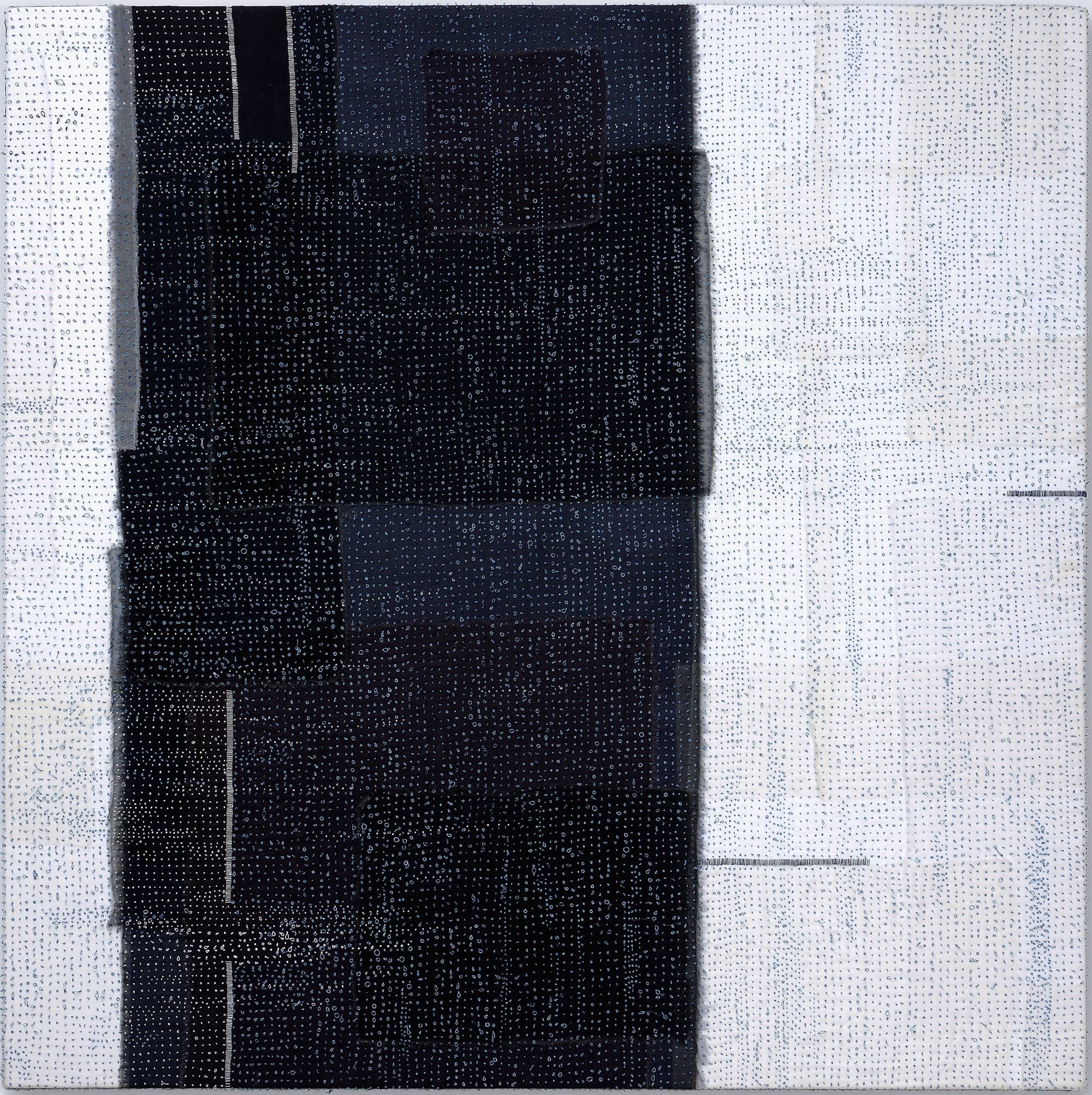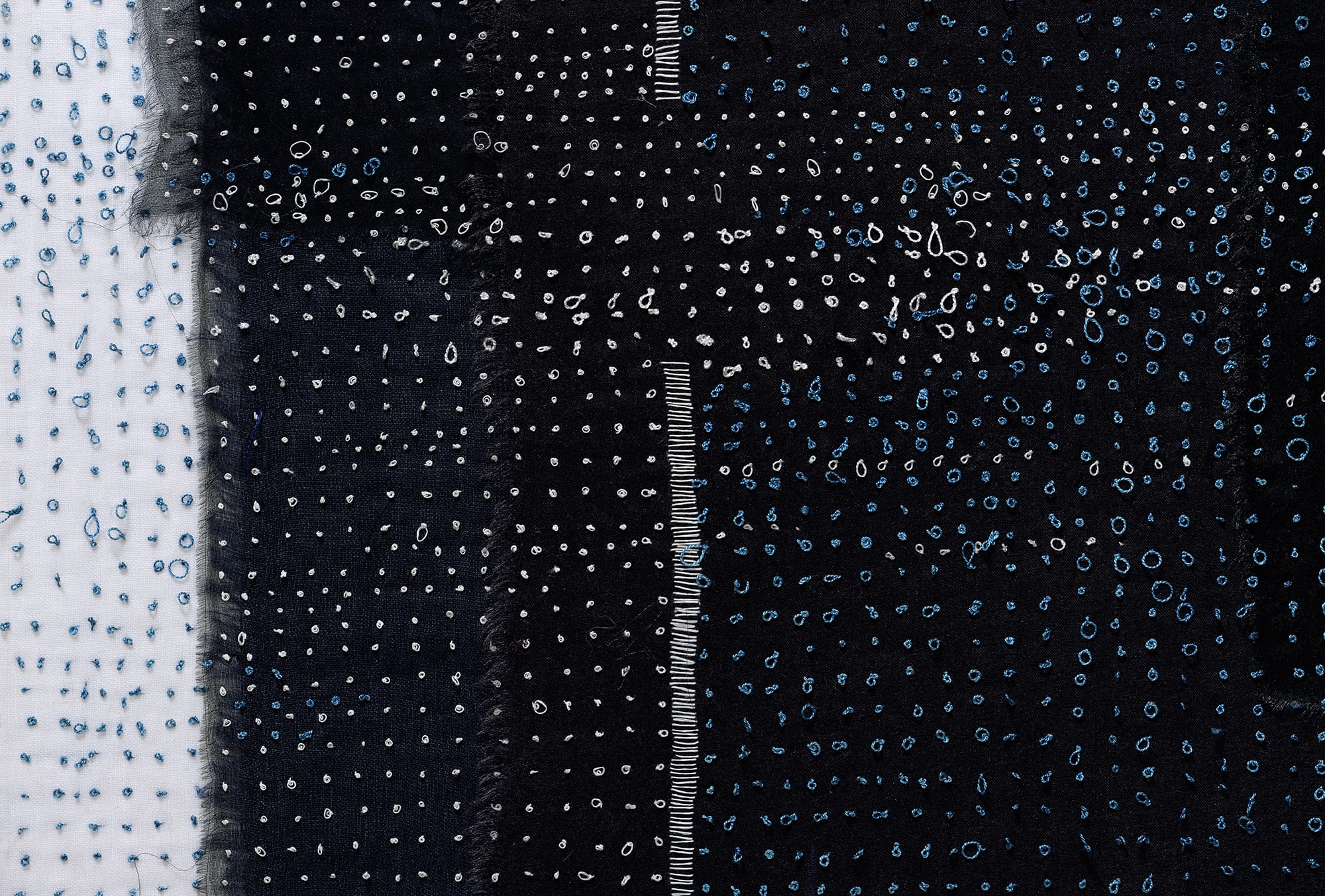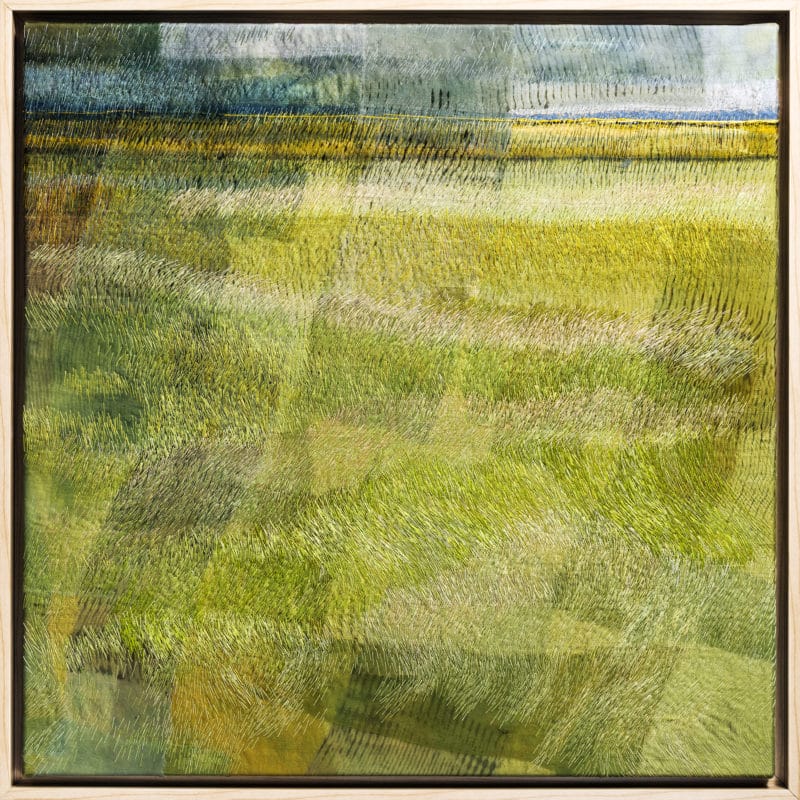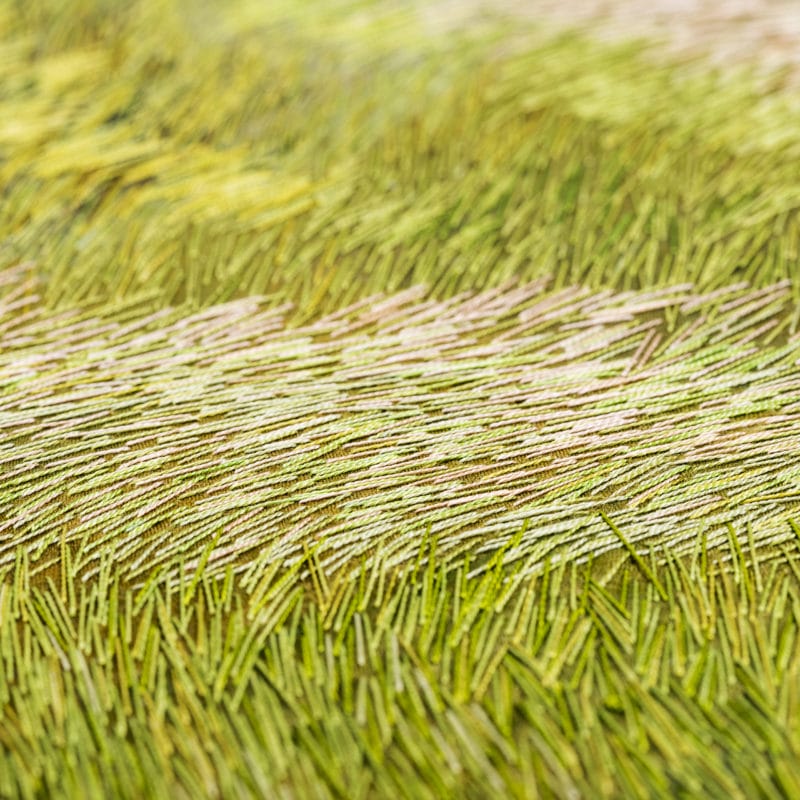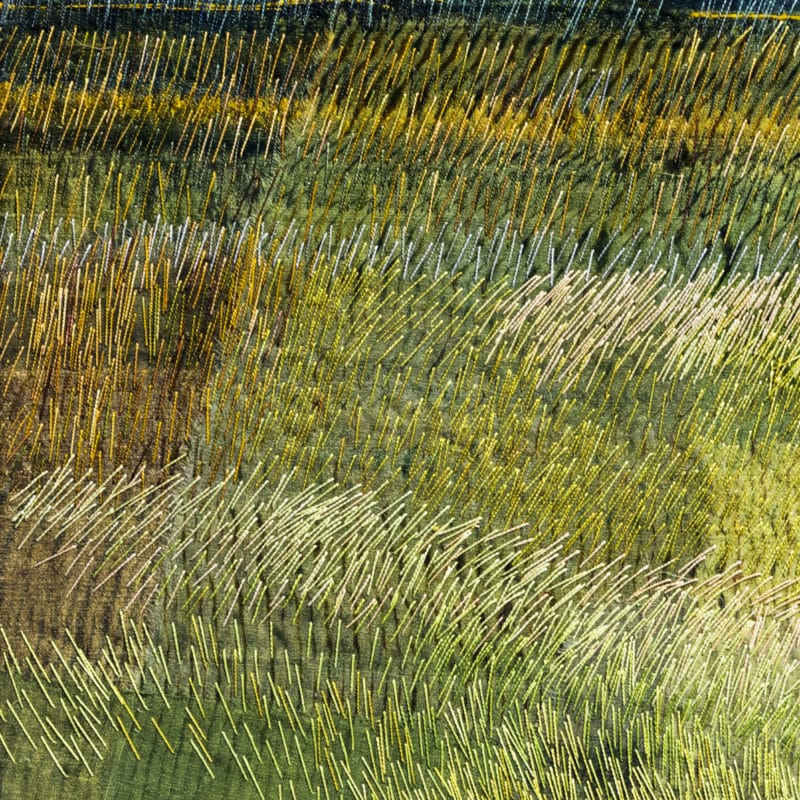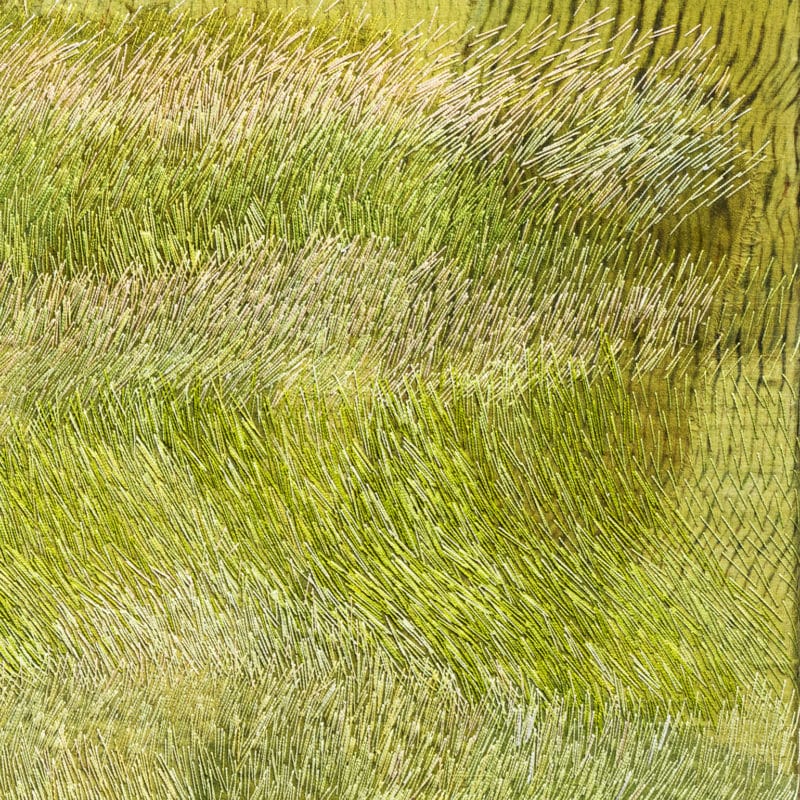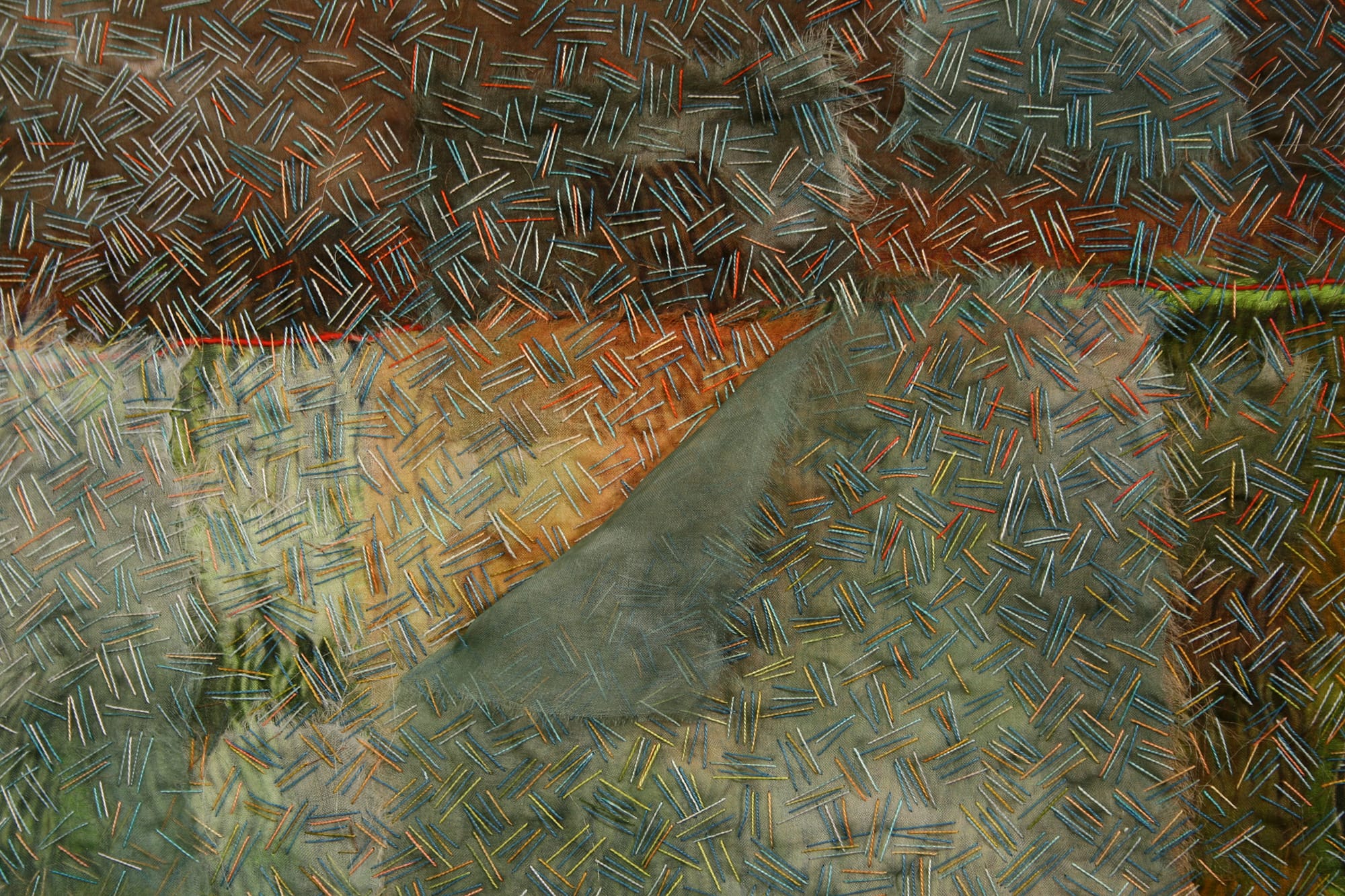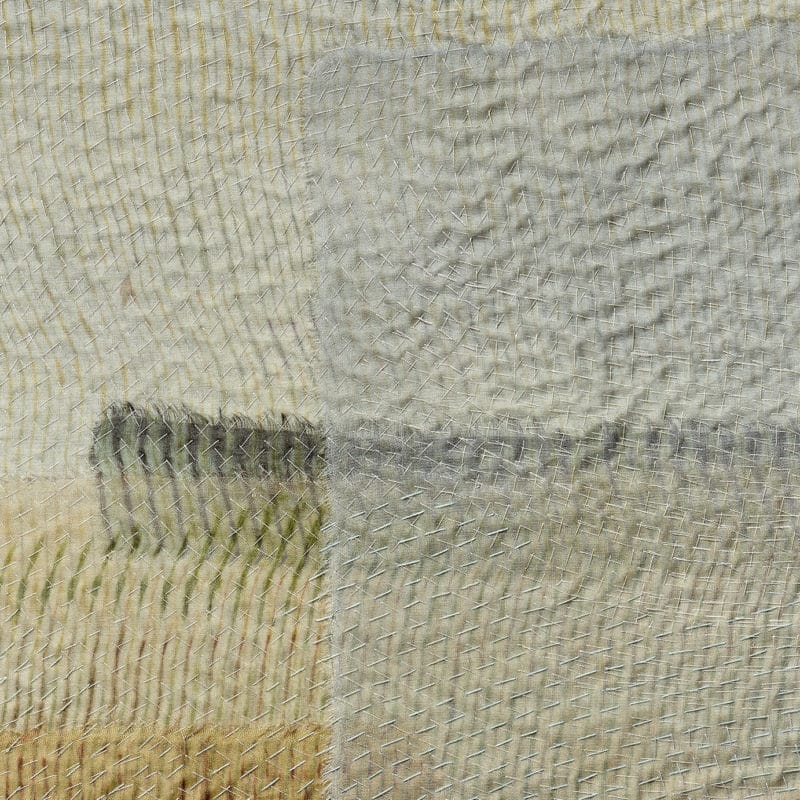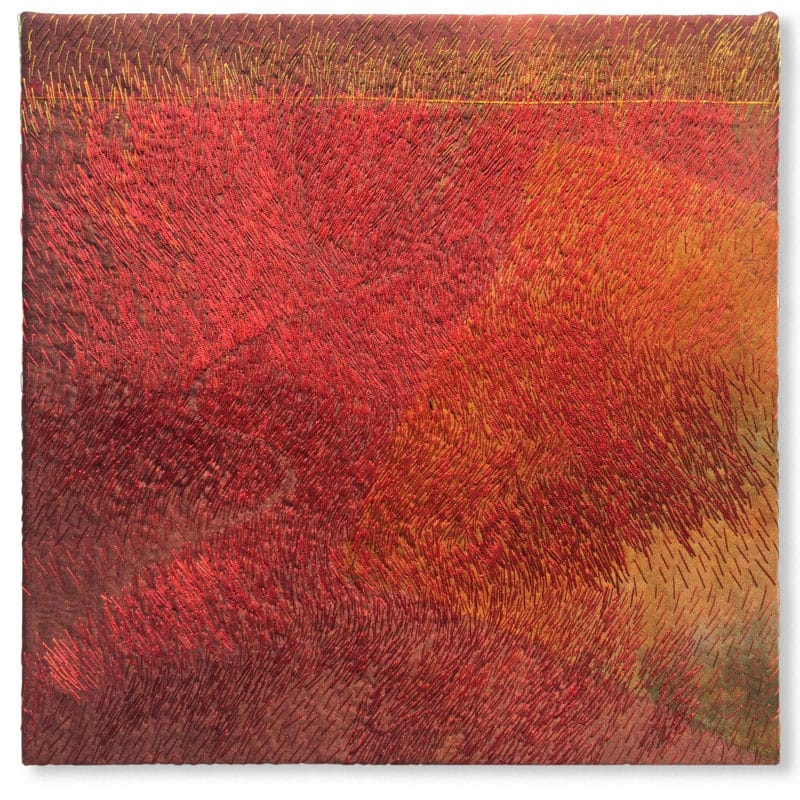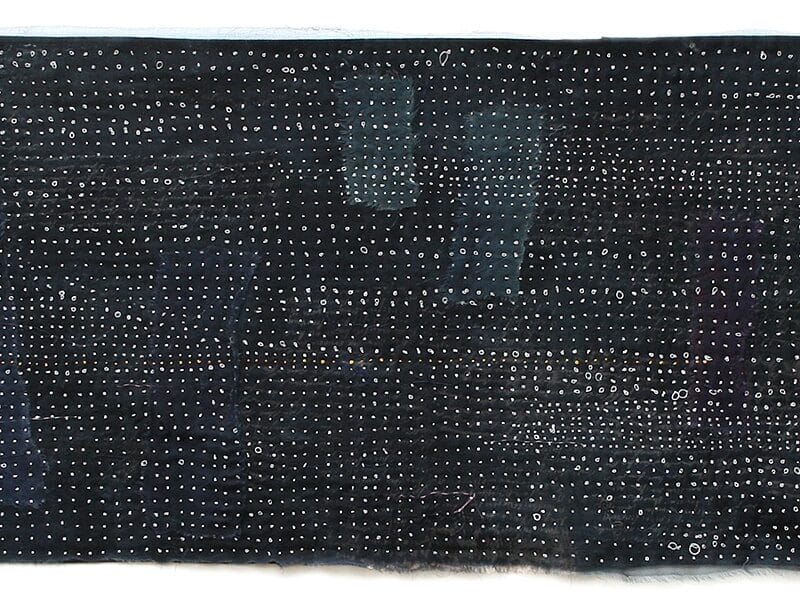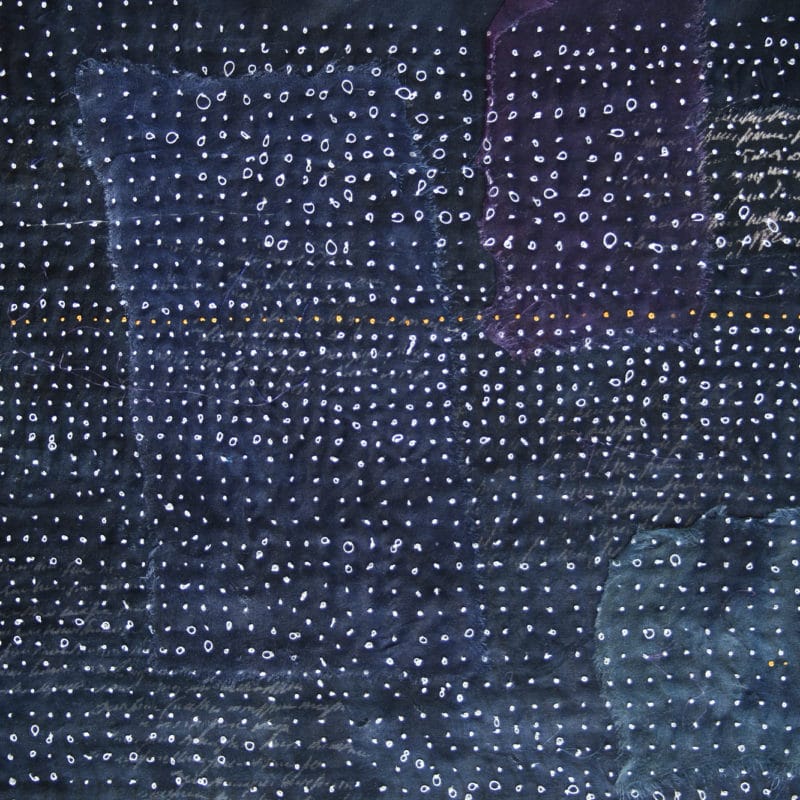“I make what I want to leave in this world”: textile art of Carolyn Nelson
When, I few weeks ago, I contacted Carolyn Nelson asking her for an interview for ArteMorbida, she replied with a generous and at the same time calm enthusiasm, the same tranquil and honest passion that I see in her work, the lawns, the sun, the air we breathe by looking at them. Sometimes it happens that a simple email exchange is enough to establish a simple and gentle harmony that brings you closer even to those who are far away.
Instead of telling who Carolyn is, speaking of the great number of exhibitions she has participated in, the awards she has received, the works exhibited in galleries and museums (all information present in full on her website) I leave the floor to her, because no one better than the artist himself can explain the poetics behind the personal creative act.
“Fragment II: from a Love Story-detail”, 2009, 28”x26”, hand stitched, hand dyed silk collage, oil monoprint on silk, copyright Carolyn Nelson
“Random Thoughts”: the artist in her words

“I create what I want to see and the only way to see it is make it. And I make what I want to leave in this world. When I work, I think about light, spirit and energy. Color. Reflection. I think about air, wind and movement. Expanse. I think about flying.
I don’t have patience; I have grit. There are times when working is joyous and flows freely; there are times when it is tedious and a struggle. I cut out half my stitches, growl and start again. Forcing myself to work can be the hardest thing I do. But I don’t quit. After working through the hardships, the excitement always returns when something imagined finally begins to work, always changed, and is coming true”.
Below is the link to the artist’s website:
Carolyn, why is your choice of artist aimed precisely at textiles as an expressive medium? Can you tell us about the path that led you to become a textile artist?
I am an obsessive stitcher and chaser of light. I grew up in a small isolated town surrounded by flat farmland. The women in my family, by necessity, were skilled seamstresses. Needle, thread and fabric were familiar comforts in my hands from an early age and became a means of grounding myself as an adult. As a child, I longed to become an artist and painted my way through school. The bones of my art work there from my beginning, disconnected.
As an adult, I hovered around art, always on the edges of my professions—teaching art in public schools and universities and working as a print designer. Art and my love of textiles danced around each other for years without holding hands until I took a workshop in illustration and textiles. I began to create the way a painter might, thinking first of concepts and then ways to express them. I reveled the freedom of making my own marks with needle and thread and loved the meditation of both physical and visual repetition. Experimentation was exciting. I was happy, I was producing original work , but I had not found a consistent “voice” or vision.
And then one day, I was standing on the edge of a wheat field in rural France. I stood still, asked for nothing, thought of nothing. It came suddenly and unexpectedly—a joyous call that was both loud and gentle, in an unfamiliar place that was deeply familiar, a feeling intensely mysterious but that I clearly understood. It was everything and its opposite. I felt myself launch. I soared. I heard my voice. I saw my vision. I became an artist.
Years later, my work continues to involve aspects of that field in France, through pattern, repetition, detail, openness, expanse and unobstructed light.
What is the meaning for you of the “gesture of embroidery”, which plays an essential role in your works?
With the simplification of materials and compositions, I ramped up the density and patterns of my stitching. The stitch is fundamental to my work, in terms of both content and energy. Stitched marks are made by the physical gestures of my hand and the threads invariably reflect those gestures, wild or measured. I do not strive for a “perfect” stitch. I love the movement of the needle through the fabric, the fluid pull of the thread, the meditation of repetition and the collective individuality of multiple stitches that reveal or conceal the background as I go, one type of simple stitch per piece. This gives me freedom to create my personal marks and imagery rather than embroidery stitches that inherently present their own imagery. A mass of unruly French knots becomes a pattern of weeds, a field of water or the paths of stars. Incomplete spirals of running stitches interlock and overlap to create a veil or mist that unites and textures a fractured surface. According to their density, backstitches create undulating masses that hide or reveal the fabrics underneath. The backstitch is most natural to me physically and the kindest to my hands.
In a new work, do you start from the material, around which you develop the idea of the subject, or do you start from the subject and then choose techniques and materials?
I approach each piece as I would approach a painting, from the aspect of concept. Taking thousands of photographs and videos of movements, I rarely refer to them. The act of taking photos solidifies something I want to remember. I imagine first and then work my way into the piece by creating and manipulating materials. I plan and modify the color, pattern or texture. I tear, layer, discard, rearrange. And then I stitch, discovering my way into my art.
As I work at the slow pace of hand stitching on one piece, I have hours upon hours to consider deepening themes or altering techniques for my next work. Before I finish one piece, I usually have a clear idea of the next one. This is how my series begin.
Can you talk about the materials you used to make your textile collages?
In the beginning, the “fields” were abstract and textural, sometimes made by repetition of bits and pieces of nature or objects I created for specific pieces. I made what I needed. Stitching was usually secondary to textured cloth. I gradually simplified my choice of materials to three fabrics that I modify through dying and surface techniques and one type of thread that I also dye and that easily slips through the four to six layers of cloth in each collage. Vision for my work is simple, choice of simple materials is in keeping with my images. (And of course, I don’t doubt that this will change one day.)
The repetition of a mark, is an element that characterizes your works, for example Soliloquy I. In your opinion, what makes repetition so interesting and attractive, almost hypnotic?
Pattern has always fascinated me. Visually, it is my way of implying an expanse that goes beyond the frame rather than a space restricted or contained. I find security in regularity and repetition of pattern but I feel exhilaration when it rebels, breaks rank, moves outward and spreads into something new or unexpected. Pattern twinkles in a way that different shapes can’t.
I began “Soliloquy I” (named that because I felt as if I was talking to myself) with the expectation that it would be a very large grid with very tiny knots in a very regular pattern and thought that the scale would create interest. It took very little time to realize it was both painfully boring to look at and even more boring to produce. By varying the loops, density, spacing and direction of stitches, it became an adventure but still maintained the pattern aspects.
The works in the “Stitching Light” series convey a strong sense of energy and lightness. Admiring How the Light Gets In, it really seems to perceive the spring wind shaking the grass of the field. Can you tell us something about how the works in this series were born?
The series Stitching Light began four years ago with a work depicting a field of red grass. I discovered that as the directions of the luminous silk stitches changed, the reflections of light on the threads also changed as I walked around in their vicinity. The fields seem to shimmer. I have created 10 pieces working with that reflected light.
“How the Light Gets In” (Thank you, Leonard Cohen for the name.) is the most realistic piece I have ever done and among my favorites. Reflecting a particular place of great solace and great energy, it nourishes me in my new home in dry, rugged Colorado. I go to this small patch of wetlands, wild with blowing grasses and moody skies, when I am yearning for my longtime, flatland home in North Carolina. The art, the place and the feeling all coincide. It is about my spirit and the spirit of place.
I am currently working on a test for a larger piece about light and the poetry happening in the vacant lot next door. The land is covered with weeds and dead grass and littered with rock, cans and papers. But for about one hour each day, when the grass is backlit by low afternoon sun, the tall grass glows with a silver-gold sheen, filling the field with light and obscuring all the trash. I am working on monoprint layers of organza to represent the obscured trash that will be overrun with lustrous, shimmering stitches. I see it. Now to get there…
I never know if this will be the last in a series or the first in another.
Improvisation, randomness, experimentation, study, rules, design. Which of these aspects has an essential or prevailing role in the creation process?
I don’t have rules— I have habits, some intentional and some by chance that I hold on to.
–I don’t use traditional references like embroidery, quilting or thread painting. While work often meets the technical definitions of these processes, the words just don’t describe the way I feel about what I do.
–I avoid using a focal point. My focus is to create an expanse of space that is understood to continue outside the dimensions of the frame. A focal point draws attention inward and arrests the movement of the eye and the imagination — patterns form, move and disintegrate without distractions. Landscapes are stripped of objects and reduce the sky to only a sliver for reference .
–I dye all surface fabrics and threads and use commercial fabrics only as backings.
–I never cut fabrics that appear on the face of my work. I tear fabric because the frayed edge is softer and blends into another color or shape better than a cut edge. I bend fabric..
–I use only natural fiber textiles because they are more receptive to surface techniques. And because each work often in my hands for months, the feel of the fabric must be comfortable. I don’t want turn my needle into a weapon and fight my cloth. It is too hard on the psyche as well as the hands.
All the exhibition are listed in the About section of website: https://www.carolynnelsonart.com

